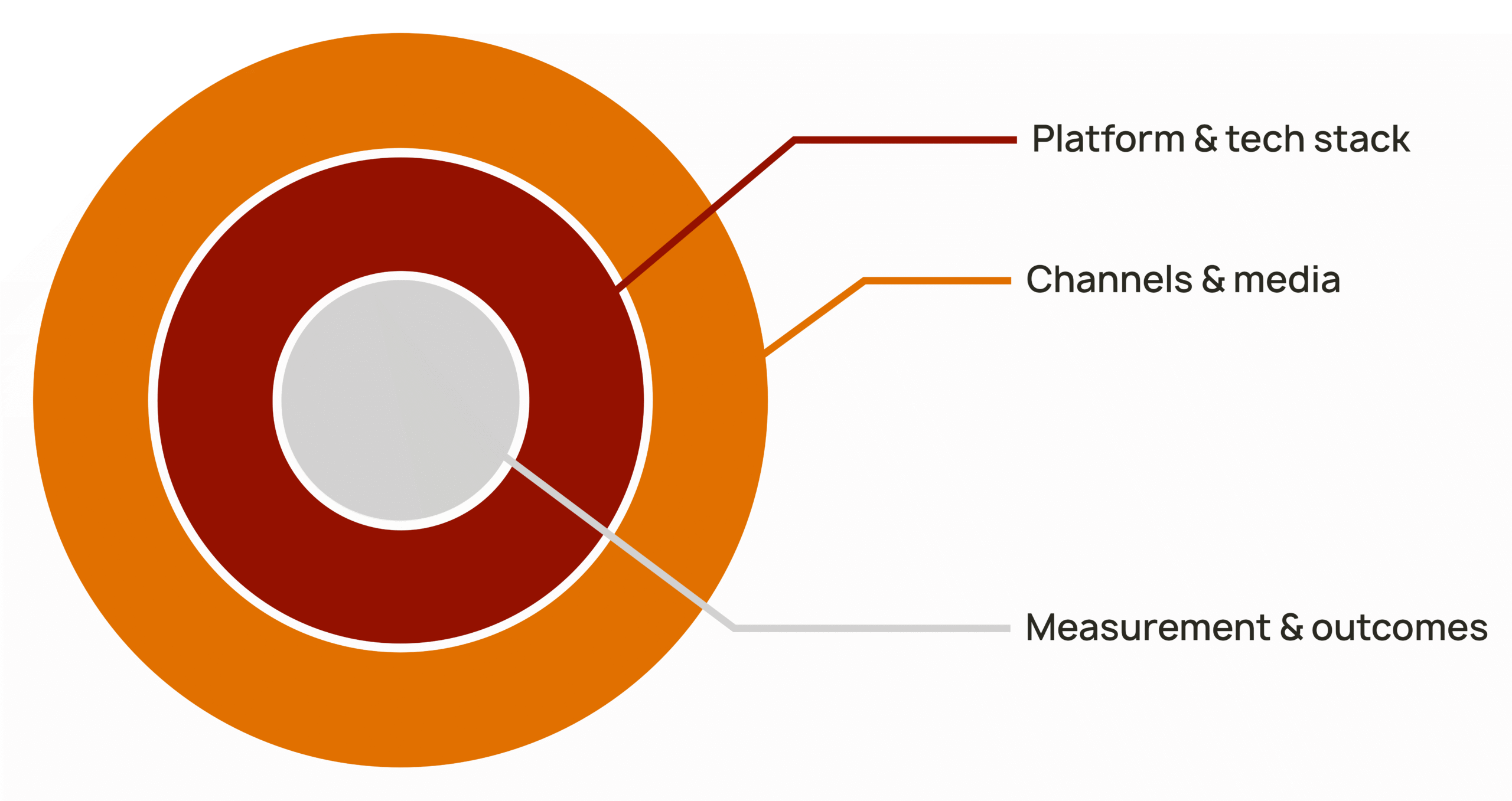Media Expertise
What makes our delivery effective at scale isn’t just the strength of our teams — it’s the infrastructure they operate. Digital media today is fragmented by nature: multiple platforms, inconsistent measurement, and high operational complexity. Without a solid system, even good execution becomes reactive.
We deliver through three core capability pillars that ensure consistency, control, and business alignment. From the channels we activate to the platforms we manage and the way we track performance, everything is integrated — not pieced together.
This structure lets us scale precisely across campaigns and markets, while maintaining quality, transparency, and cost control. It’s how we embed media as a managed business function, not a disconnected service line.
3 Pillars of Pure Play Media Expertise
Expert Teams
Ownership
Integration
The channel layer is where media comes to life — across display, video, social, search, programmatic, retail media, and emerging platforms.
It’s the executional front of the operation, where strategic intent and platform setup are translated into real audience impact.
We operate across all key digital environments with precision, neutrality, and full alignment to business goals.

The platform layer is the operational backbone of our media delivery model. It includes all the tools used to plan, activate, measure, and optimize campaigns — from ad servers, DSPs, and retail media platforms to analytics environments, tagging systems, and verification tools.
We ensure the stack is properly configured, integrated, and governed to deliver consistent, high-quality execution. Whether the technology is owned by the Client or managed by Pure Play, we operate it with full transparency and accountability. This layer connects business logic with media systems — enabling both day-to-day efficiency and long-term control.

The measurement layer sits at the center of our media delivery model because outcomes guide everything we do. We align with the Client’s definition of success — not just clicks or impressions, but actual contribution to revenue, efficiency, and profitability. This means structuring KPIs that reflect real business impact, not vanity metrics.
We build the infrastructure to support that: clean tagging, reliable data capture, consistent attribution, and audit-ready reporting. Our approach combines platform analytics with deeper performance insights — including incrementality, cost contribution analysis, and procurement-level saving indexes.
Measurement for us isn’t a post-campaign summary — it’s an operational control system. It drives optimization, informs budgeting, and provides the transparency Clients need to make confident, fact-based decisions. It’s not what we look at after delivery — it’s what defines it.
Pure Play Key Media Competences
Media expertise at Pure Play is grounded in practical execution across all major digital environments — not theoretical capability. Our teams operate in high-complexity, high-scale setups where each channel has its own logic, risks, and optimization rules. We don’t just understand how platforms work — we know how to make them deliver results under real business constraints.
From CTV to search, from performance-led ecommerce to large-scale programmatic, we bring platform fluency, audience intelligence, and channel-specific know-how. This expertise is not siloed — it’s embedded in our operations, connected to planning, technology, measurement, and governance. It’s what ensures that strategy becomes performance, and investment becomes impact.

CHANNELS & MEDIA
We operate across all key digital channels — but more importantly, we understand how different media types function within them. Every environment has its own architecture of content, placement, targeting, and intent — and we treat these dimensions as operational variables, not creative expressions.
Search
In Search, we differentiate between branded queries, non-branded traffic, shopping feeds, dynamic product ads, and local extensions. Each is mapped to a specific role in funnel velocity, margin sensitivity, and competitive context.
Programmatic
In Programmatic Display, we work across static, dynamic, video, and high-impact formats — using audience signals, frequency controls, and media quality thresholds to build cost-effective reach and upper-funnel demand.
Social
In Social, we balance short-form video, static formats, carousels, and collection ads — testing creative variants and optimizing placements per platform logic. Prospecting and retargeting strategies are not creative sets, but performance systems governed by data loops.
Video
In Video & CTV, we deploy skippable and non-skippable formats, short- and long-form assets, and dynamic sequencing — tailored to both awareness and lower-funnel lift. CTV is treated not just as “TV”, but as an addressable medium with platform constraints and learning cycles.
Retail Media
In Retail Media, we differentiate between sponsored products, branded placements, display overlays, and off-site retargeting — treating media not just as inventory, but as an extension of the shelf and category strategy.
Other digital media
Even in Email, Push & Messaging, we classify assets and placements by trigger logic, conversion intent, and CRM integration level — because media delivered to owned audiences also requires optimization.
We don’t plan “channels” and then add creative. We build media strategies around the actual interaction models, cognitive load, and value-exchange logic behind each ad experience. That’s what turns media from exposure into performance.
PLATFORMS & TECH STACK
We use platforms with structure, consistency, and accountability. The tech stack is not an accessory to execution — it is the system that determines how precisely, transparently, and repeatably digital media can be delivered. At Pure Play, we treat technology as a controlled asset, not an outsourced tool.
We manage and configure the full advertising stack — from planning and buying interfaces to measurement, verification, and reporting environments. Whether the infrastructure is Client-owned or operated by Pure Play, we ensure every system is implemented with correct access, taxonomy, automation logic, and governance standards. Platform hygiene is not optional — it’s foundational.
We operate platforms such as DV360, Google Ads, Meta Ads Manager, TikTok Ads, Amazon DSP, and Adform with defined role structures and naming conventions. Every campaign setup follows documented logic: budget segmentation, bidding architecture, pacing control, and audience framework.
For measurement and attribution, we run tools like Campaign Manager (CM360), Google Analytics (GA4), Looker Studio, server-side GTM, and event-based tracking systems. We also manage tagging frameworks, conversion signals, and validation layers with DoubleVerify, IAS, or Moat — ensuring quality, viewability, and brand safety.
Our dashboards are not pre-built templates — they’re customized to reflect Client business logic, operational rhythms, and performance models. Whether for daily operations or executive reporting, our tech stack serves decision-making — not decoration.
Ultimately, our platforms are designed to integrate, not fragment. Data flows from execution to insight, from tagging to optimization, from budget to performance. This is what makes the stack operational — not just functional.
MEASUREMENT & OUTCOMES
Measurement is not an afterthought — it is the operational mechanism that drives decision-making, optimization, and accountability across the entire media process. Outcomes are not simply observed; they are defined, structured, and managed from the very start of each campaign.
The focus is on what matters to the business: contribution to revenue, cost efficiency, margin improvement, and return on investment. Performance metrics like cost per result, conversion efficiency, and ROAS are tracked alongside commercial indicators such as media-driven uplift and savings index impact. These metrics are not isolated; they are embedded in planning and used to inform budget decisions in real time.
Measurement frameworks are built on solid infrastructure — including server-side tagging, platform-level tracking, incrementality testing, and fully customized reporting dashboards. Data is structured and sourced from tools like GA4, Campaign Manager, Looker Studio, and custom attribution models, always with auditability and transparency in mind.
Every result can be traced back to a decision, a configuration, and a budget allocation. This is what enables real optimization — not reactive reporting, but forward-looking control. Measurement is the system that ensures media serves the business — not just the campaign.

